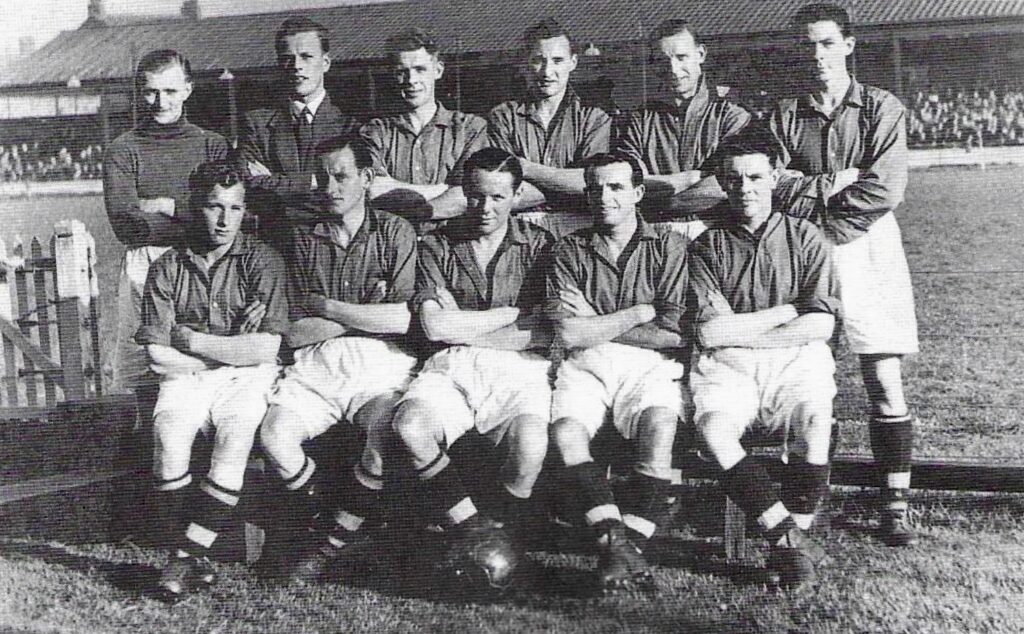William Lyons was born on 29th September 1926 at 110 Maple Street, Ashington. He was the son of Daisy Besford and her husband William Lyons. He was always known to my mother and Uncle David (his cousins Dorothy Jane Besford and David Besford) as Willy.

Willy worked as a milk roundsman and subsequently as the driver of the funeral hearse. I believe that both these jobs were with the Co-Op.
Willy was a fine sportsman who for some years earned money as both a professional footballer and a professional sprinter.
Willy was signed by Ashington F.C. as a part-time professional to play for them as an outside-right in the North Eastern League. This league was of a relatively high standard, containing, amongst others, Sunderland Reserves, Middlesbrough Reserves and Carlisle United Reserves. Willy was a fast and tricky right-winger. Newspaper reports record him making goals for others on a regular basis, as well as scoring himself occasionally.
A report on the Ashington vs. North Shields match (result 7-2 to Ashington) in the Morpeth Herald of 11th March 1949 states:
“Not for many matches have the wingers done so much work. Lyons, the speedy outside-right, was the real danger point. His tremendous bursts of speed were always too much for the Fishermen. The bulk of Ashington’s goals came from this wing.”
Willy himself scored two of the seven goals.

He performed so well that he became a target for Football League clubs:
“Representatives of Grimsby Town, Middlesbrough, Barnsley and Burnley watched Ashington outside right W. Lyons. Burnley have already made an unsuccessful bid for his transfer, and this was the fourth game in succession they had him watched.”
Blyth News, 14th March 1949
Reading this report I wondered why Willy did not end up playing as a full-time professional for Burnley who, it should be noted, were then a First Division club. There would have been some risk involved for him had he gone full-time professional. He would obviously have had to give up his job as a milk roundsman and move away from Ashington. He would of course have lost his part-time professional wages with Ashington F.C., but he would also have had to give up his professional sprinting career. In other words three sources of income would have been replaced by one. There was a maximum wage in place in football in this era and there would also have been the risk that he did not make the grade at that level. Whether this was the reason he stayed as a part-timer with Ashington we will never know, but it is at least a plausible explanation.
Willy’s professional sprinting, if anything, had a higher profile than his football career.
A report in the Blyth News in August 1949 on Ashington F.C.’s pre-season reads as follows:
“Last season’s fast winger Lyons was unable to appear because of an injured hand and it is not yet known whether he will be reserved until the New Year, when he takes part in the Powderhall Handicap.”
He won many local races and was a regular competitor (and finalist) at the famous annual Powderhall Sprint in Edinburgh. Professional sprinting involved official handicappers assessing the form of the competitors and giving them handicaps such that a blanket finish might be achieved. There was widespread betting on the outcome of races. The practice was for competitors to run under assumed names, but for these names to be used regularly. Willy raced as “W. Weaver”.

He featured regularly in press reports:
“Two men who trained side by side on a private track at Silloth on the Solway Firth, free from prying eyes, and a third who for weeks had been showing his paces before tenement housewives doing their chores, are the favourites for this year’s Powderhall sprint. Runners from Silloth are the Blyth painter, W. Spence, who won two years ago, and W. Weaver of Ashington. Both won their heats yesterday without being at all extended. Challenging them is G. Georges, a familiar figure of the Meadowbank running track for weeks past. Georges was installed as favourite at 9-4 against. Second favourite is Spence, certainly the fastest professional sprinter in Britain, and third, Weaver, another runner with a perfect action.”
Sunday Mail, Glasgow, 2nd January 1949
In 1951, when Eric Cumming, the world-famous Australian sprinter, came to Britain, Willy Lyons took part in a one-off race against him:
“Eric Cumming, the Australian professional sprinter, is thoroughly enjoying his stay in Scotland. He is not, however, restricting himself solely to the Scottish summer games, and tonight he ventures south of the Border to Brough Park, Newcastle, where he is due to run against W. Weaver, Ashington, in a special exhibition race. Weaver is well known to Edinburgh followers of the game as a competitor in the Powderhall Handicap.”
Edinburgh Evening News, 19th June 1951
Willy Lyons married Stella Woodhouse in 1954.
I can remember him visiting us and having my mother in stitches laughing. He used to take great delight in parking up in the empty hearse and either eating his lunch or calling on someone he knew down the street, resulting in curtains twitching as people wondered who had died.